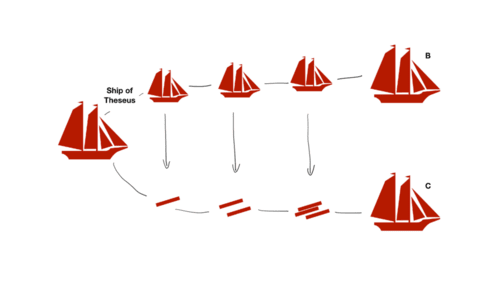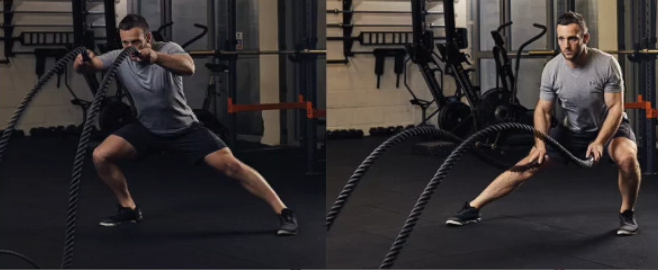Material and Formal Entities (BPC)
| Broad Physical Categories (BPC) | Definition |
|---|---|
| 9. Material conditioning | A conditioning connection between the matter of an entity and its properties. |
| 10. Formal Conditioning | A conditioning connection between the form of an entity and its properties. |
| 13. Material entity | An entity having particular properties which are the result of material conditioning. |
| 14. Formal entity | An entity having particular properties which are the result of formal conditioning. |
Two concepts based on Aristotle's matter-form distinction.

Demonstration: the ship of Theseus.
We can demonstrate these with a common story—the ancient Greek riddle called the Ship of Theseus. Theseus was a Greek hero who sailed around the Mediterranean for several decades. As he sailed, different parts of his ship wore out and got replaced. The riddle is this: if after many years every plank, rope, and sail has been replaced, is it still the same ship? Or let's say you somehow collected all the old parts that got replaced and made a really decrepit Ship of Theseus out of them—is that the actual Ship of Theseus?
The answer to this riddle depends on if we are referring to the ship as a material entity or as a formal entity. If the original ship was made out of some kind of special wood and we wanted to get a piece of that special kind of wood, then we are concerned with the ship as a material entity—the entity whose properties are the result of it being made out of a particular material.
If instead we are interested in the properties that result from the particular relationships between the parts, such as a certain cargo space, crew capacity, or the property of being the actual Ship of Theseus that carried Theseus around on his voyages, then we are concerned with the ship qua formal entity. We aren't concerned with the material but with a persisting arrangement of changing materials that creates an entity *with those particular properties of Theseus's ship.
Both perspectives—that of material entities and of formal entities—are crucial. Remember that what we take to be an entity can change depending on our perspective, and it's critical that we can look at things from both perspectives.
The material entity perspective is crucial because some properties are the result of matter. If you burn a log and the ash remains, then the ash is the same material entity as the log was. You know this because the ash occupies the same position in space that the wood used to.
This helps us in chemistry, because it's important to think about material entities in chemisty. Lavoisier urged his fellow chemists to take careful measure of the exact weights of chemicals they put into their reactions and to also measure the weight of materials they got out of their reactions. If no weight was added or lost during a reaction, then chemists could use the concept of formal entity and material entity to know they were dealing with the same material entities and that any changes to the properties of their substances would be caused by changes in form.
At the same time, treating things as entities based on their form while disregarding matter is also a crucial perspective. The human body is an entity even though it is constantly swapping out materials—hair falls out, skin regrows, etc. Every atom in the human body gets replaced over the course of about five years, but the body is still an entity because the relationships between its constituents remain the same despite the loss and replacement of materials. An important example of a formal entity is a wave:

Waves as an Example of Formal Entities
When one whips a rope, it produces a hump in the rope that travels forward. Something which is decieving about this is that no one particular piece of rope is actually moving forward; each piece of rope is only moving up and down. It's the hump that moves forward.
This hump can properly be seen as an entity if we take the right perspective. It has particular properties, a shape and position, and commits particular actions, causing a force on the hand holding the other side of the rope once it gets there. These properties result from the particular set of relationships between the parts, maintained even though parts are constantly being changed out as the hump moves forward across the rope. The bits of rope in front of the hump are introduced into the entity, while the bits of rope at the back of the hump are shown out of the entity.
Jame Ellias on his reconceptualization of entity:
"My radical reformulation of the concept entity—that an entity is an existent with its own properties—allows us for the concept of formal entity, which in turn gives us an objective basis for calling the human body or a wave an entity. That basis is that properties of such entities persist even when their matter changes. I think this will one day help us make inferences about quantum phenomena. In quantum phenomena, many physical entities such as electrons are found to have the characteristics of a wave. We want the ability to be flexible about what we call an entity while still being objective about what we are calling an entity."